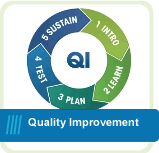Quality Improvement
Key Message

 Quality
Improvement is the foundation of the Healthcare Quality Strategy
for NHSScotland and focuses on the design of systematic and
sustainable change initiatives to continuously improve the quality
of healthcare delivered.
Quality
Improvement is the foundation of the Healthcare Quality Strategy
for NHSScotland and focuses on the design of systematic and
sustainable change initiatives to continuously improve the quality
of healthcare delivered.
Quality Improvement impacts on the entire organisation, with a particular focus on a bottom up approach where the people on the ground are encouraged and supported to identify changes and articulate what the change should look like.
Each improvement project should follow a systematic approach from discovering and exploring the change initiative, through to designing, refining and introducing the change, rolling out the change and sharing learning with others. Metrics to measure the impact of change on service delivery are vital to establish if changes are being successfully implemented and followed, to assess whether patient outcomes are improving and to identify further opportunities for improvement.
What does this mean for the Effective Practitioner?
Quality Improvement is about making measurable improvements in the quality of care that patients, their families and carers and those providing healthcare services see as being really important. It encourages the practitioner to come up with new ways of working and lead on initiatives with support and guidance from local Quality Improvement facilitators.
![]() You can download a copy of
the
Quality
Improvement learning activities.
You can download a copy of
the
Quality
Improvement learning activities.
Reflection
Remember, recording your reflections is an important part of the learning process. Take time to structure your thoughts, feelings and any future actions on one the forms available in the Reflective Practice section. Click here to visit the page.
In your reflections you could also consider how your learning relates to the Clinical Practice, Facilitation of Learning and Leadership pillars of practice.
Return to top
